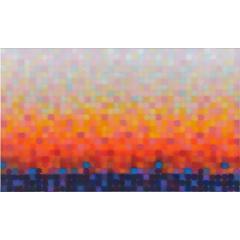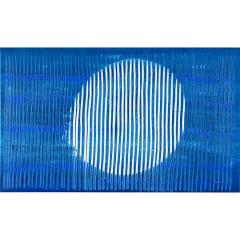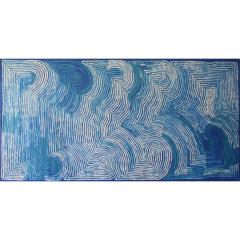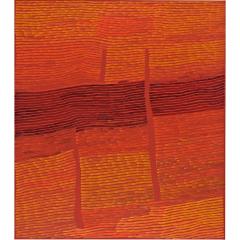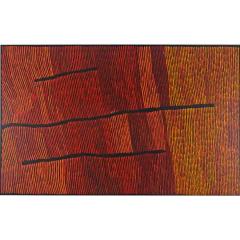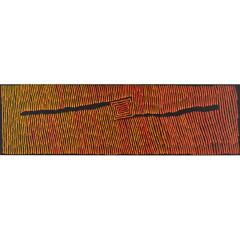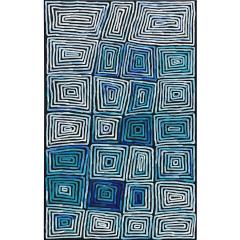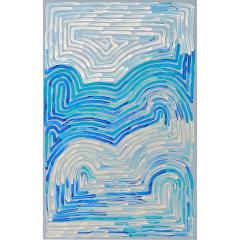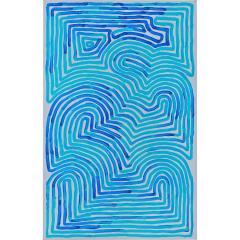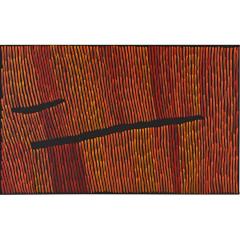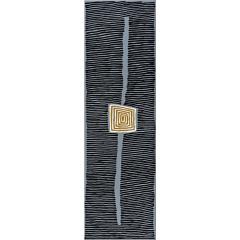Weather Patterns
Weather Patterns is a group show that umbrellas three Australian artists. All three artists work in the realms of abstract painting, reflecting the vagaries of weather and the extremities of our landscape: Rosella Namok from Cape York – tropical, wet season impressions; Matthew Johnson from Melbourne – atmospheric, subdued expressions light; and Ronnie Tjampitjinpa of the Western Desert – primal marks, ancient and iconic stories.
Director Michael Eather, who has assembled the three artists together, has often commented on how Indigenous and non-Indigenous artists sometimes cross over via the subtleties of their respective visual vernaculars. Weather is a universal phenomenon, as is the language of paint.
The works of Namok and Tjampitjinpa are sometimes compared on an aesthetic level, but their geography could not be more different. The comparisons stem from the shared magnificent rain stories, inspired by their Indigenous origins. Johnson sums up his recent selections as my work emulates an abstract environment based upon variables in nature and the manmade. Weather remains the kinetic makeup of the atmosphere.
The three artists assembled together within Weather Patterns imbue the diversity of Australian light and atmosphere, and the embedded stories we all share.
Artworks
In Weather Patterns, Michael Eather’s curatorial approach - that artists from backgrounds Indigenous and non-Indigenous have much in common - is at the fore. It may seem an unusual conjunction to include Melbourne-based Matthew Johnson’s highly mediated abstract paintings with other patterned and rhythmic canvases that have their genesis in a more every day experience of weather. Rosella Namok’s large scale abstract paintings evoke the dampness of the wet season, their vertical rain saturated with north Queensland tropical colour. Ronnie Tjampitjinpa’s sinuous surfaces seek out the macro and microcosm of nature and the organic, in their depictions of rain, fire, and ceremony. For Johnson, Weather remains the kinetic makeup of atmosphere and his series of colourful pixelated abstracts analyse and meditate on the liminal line of the horizon, evoking states of transitory impressions, being and seeing. Yet Weather Patterns allows for a sensibility that successfully bridges these individual and perceptual gaps. The experience of being in the environment and its weathers is intrinsic to human experience of the world, and is felt in each of the canvases selected for this evocative exhibition.
A weather pattern is depicted visually as a system of air masses that overlay the continent, or the globe, with topographical lines. The wandering tension within their natural variance is picked up by the approximate parallels in the hand painted lines created by Tjampitjinpa (Pintupi, Western Desert), who also shows the way in which Indigenous story has overwritten country, able to be unpicked by an artistic exploration. His Blazing Fire Lines (2015), in burnt orange and black, evokes heat with an aerial sensibility - overlooking the scarifying fire as the orange and yellow lines are cut across, like cicatrice, with the black scars of experience.
Rosella Namok, whose work is based in colour gradations to evoke the atmospherics of the Lockhart River (Cape York Peninsula), disrupts the picture plane with the strongly vertical parallel lines of the rains that dramatically impact the landscape. Eather noted, The Stinging Rain imagery has become a powerful and evocative landscape arrangement for Rosella. After layering multi-coloured, high gloss paints, she allows them to dry, and with the final wet coat she will ‘whip’ the painted surface with long thin sticks, creating the rhythmic patterns of the driving rain commonplace in the tropics. It is an action painting that brings the physicality of Namok into play.
Johnson’s paintings speak to his highly urban existence (and that of the majority of Australians): We are conditioned daily by thousands of pieces of visual peripheral information to the point that a sunset or sunrise is not an experience but merely a conditioned image. Nature has become an electronic memory. Yet Johnson’s patterns (for example Air Imbued, 2015), are as powerful an evocation of fading light, and a changing daily viewpoint, as Namok’s blustery showers (Wet season … ya come 2015) and Tjampitjinpa’s Black and White Fire Breaks (2015). Each artist depicts the elements - the extremities of city and country - and explore responses that most may share.
Weather Patterns utilises the colours of nature, the black and the white, to evoke the universality of the human experience, in the atmospherics of the world in which we live and their individual sensory experiences - be it the rain on our faces, the heat in the ground, or the liminal light of the screen.
Courtesy of Louise Martin-Chew 2015



